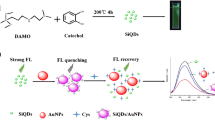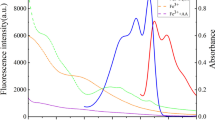Abstract
The authors describe a new chemiluminescence (CL) system composed of Si-doped carbon dots (Si-CDs), Fe(II) ions, and K2S2O8. The Si-CDs were prepared by a hydrothermal method and characterized by fluorescence spectra, transmission electron microscopy, energy-dispersive X-ray and FTIR spectroscopy. The weak CL of the Fe(II)-K2S2O8 reaction is found to be intensified by a factor of ~125 in the presence of Si-CDs. The possible mechanism for CL and its enhancement was studied by recording fluorescence and CL spectra and by investigating the effect of some radical scavengers. It is found that norfloxacin exerts a strong enhancing effect on the CL intensity of the system. This finding was employed to design a CL-based norfloxacin assay that works in the 5.0 to 300 μg L−1 concentration range, with a limit of detection (3 σ) of 1.5 μg L−1. The method was applied to the determination of therapeutic levels of norfloxacin in spiked human plasma and gave satisfactory results.

Schematic of the new chemiluminescence system. It consists of silica-doped carbon dots, Fe(II) ions and K2S2O8 and was applied to the determination of norfloxacin which exerts a strong enhancement effect.




Similar content being viewed by others
References
Zheng XT, Ananthanarayanan A, Luo KQ, Chen P (2015) Glowing graphene quantum dots and carbon dots: properties, syntheses, and biological applications. Small 11(14):1620–36
Lim SY, Shen W, Gao Z (2014) Carbon quantum dots and their applications. Chem Soc Rev 44(1):362–81
Zuo P, Lu X, Sun Z, Guo Y, He H (2016) A review on syntheses, properties, characterization and bioanalytical applications of fluorescent carbon dots. Microchim Acta 183(2):519–42
Du Y, Guo S (2016) Chemically doped fluorescent carbon and graphene quantum dots for bioimaging, sensor, catalytic and photoelectronic applications. Nanoscale 8(5):2532–43
Qian Z, Shan X, Chai L, Ma J, Chen J, Feng H (2014) Si-doped carbon quantum dots: a facile and general preparation strategy, bioimaging application, and multifunctional sensor. ACS Appl Mater Interfaces 6(9):6797–805
Fu C, Qiang L, Liang Q, Chen X, Li L, Liu H (2015) Facile synthesis of a highly luminescent carbon dot@silica nanorattle for in vivo bioimaging. RSC Adv 5(57):46158–62
Jiang Y, Wang Z, Dai Z (2016) Preparation of silicon–carbon-based dots@dopamine and its application in intracellular Ag + detection and cell imaging. ACS Appl Mater Interfaces 8(6):3644–50
Shih C-C, Chen P-C, Lin G-L, Wang C-W, Chang H-T (2015) Optical and electrochemical applications of silicon–carbon dots/Silicon dioxide nanocomposites. ACS Nano 9(1):312–9
Rao H, Liu W, Lu Z, Wang Y, Ge H, Zou P (2016) Silica-coated carbon dots conjugated to CdTe quantum dots: a ratiometric fluorescent probe for copper(II). Microchim Acta 183(2):581–8
Lin Z, Dou X, Li H, Chen Q, Lin J-M (2014) Silicon-hybrid carbon dots strongly enhance the chemiluminescence of luminol. Microchim Acta 181(7–8):805–11
Whalen K, Finkel R, Panavelil TA. Pharmacology (2014)
Yu X, Jiang Z, Wang Q, Guo Y (2010) Silver nanoparticle-based chemiluminescence enhancement for the determination of norfloxacin. Microchim Acta 171(1–2):17–22
Yao W, Wang L, Wang H, Zhang X (2008) Cathodic electrochemiluminescence behavior of norfloxacin/peroxydisulfate system in purely aqueous solution. Electrochim Acta 54(2):733–7
Sun H, Chen P, Wang F (2009) A novel chemiluminescence reaction system for the determination of norfloxacin with Ag(III) complex. Spectrochim Acta A Mol Biomol Spectrosc 74(3):819–24
Yu X, Bao J (2009) Determination of norfloxacin using gold nanoparticles catalyzed cerium(IV)–sodium sulfite chemiluminescence. J Lumin 129(9):973–8
Liu Y-M, Mei L, Yue H-Y, Shi Y-M, Liu L-J (2010) Highly sensitive chemiluminescence detection of norfloxacin and ciprofloxacin in CE and its applications. Chromatographia 72(3–4):337–41
Chen S-L, Liu Y, Zhao H-C, Jin L-P, Zhang Z-L, Zheng Y-Z (2006) Determination of norfloxacin using a terbium-sensitized electrogenerated chemiluminescence method. Luminescence 21(1):20–5
Kamruzzaman M, Ferdous T, Alam A-M, Lee S-H, Kim S-Y, Kim Y-H (2011) A metal enhanced flow-injection chemiluminescence method for the rapid determination of norfloxacin in pharmaceutical formulations and serum sample. Bull Kor Chem Soc 32(2):639–44
Amjadi M, Manzoori JL, Hallaj T, Sorouraddin MH (2014) Strong enhancement of the chemiluminescence of the cerium(IV)-thiosulfate reaction by carbon dots, and its application to the sensitive determination of dopamine. Microchim Acta 181(5–6):671–7
Amjadi M, Manzoori JL, Hallaj T (2015) A novel chemiluminescence method for determination of bisphenol Abased on the carbon dot-enhanced HCO3 −–H2O2 system. J Lumin 158:160–164
Niu H, Yuan R, Chai Y, Mao L, Yuan Y, Zhuo Y (2011) Electrochemiluminescence of peroxydisulfate enhanced by l-cysteine film for sensitive immunoassay. Biosens Bioelectron 26(7):3175–80
Yuan D, Chen S, Zhang J, Wang H, Yuan R, Zhang W (2013) An electrochemiluminescent sensor for phenolic compounds based on the inhibition of peroxydisulfate electrochemiluminescence. Sensors Actuators B Chem 185:417–23
Li J, Wang N, Tran TT, Huang C, Chen L, Yuan L (2013) Electrogenerated chemiluminescence detection of trace level pentachlorophenol using carbon quantum dots. Analyst 138(7):2038–2043
Santana RMM, Oliveira TD, Rodrigues SSM, Frigerio C, Santos JLM, Korn M (2015) Enhancing reactive species generation upon photo-activation of CdTe quantum dots for the chemiluminometric determination of unreacted reagent in UV/drug degradation process. Talanta 135:27–33
Zhang H, Zhang X, Dong S (2015) Enhancement of the carbon dots/ K2S2O8 chemiluminescence system induced by triethylamine. Anal Chem 87(22):11167–70
Chen J, Liu W, Mao L-H, Yin Y-J, Wang C-F, Chen S (2014) Synthesis of silica-based carbon dot/nanocrystal hybrids toward white LEDs. J Mater Sci 49(21):7391–8
Reshetnyak OV, Kovalchuk EP, Skurski P, Rak J, Blazejowski J (2003) The origin of luminescence accompanying electrochemical reduction or chemical decomposition of peroxydisulfates. J Lumin 105:27–34
Wu J, Zhang H, Qiu J (2012) Degradation of acid orange 7 in aqueous solution by a novel electro/Fe2+/peroxydisulfate process. J Hazard Mater 215–216:138–45
Jiang J, He Y, Li S, Cui H (2012) Amino acids as the source for producing carbon nanodots: microwave assisted one-step synthesis, intrinsic photoluminescence property and intense chemiluminescence enhancement. Chem Commun 48(77):9634
Dou X, Lin Z, Chen H, Zheng Y, Lu C, Lin J-M (2013) Production of superoxide anion radicals as evidence for carbon nanodots acting as electron donors by the chemiluminescence method. Chem Commun 49(52):5871
Amjadi M, Manzoori JL, Hallaj T (2015) A novel chemiluminescence method for determination of bisphenol Abased on the carbon dot-enhanced;–H2O2 system. J Lumin 158:160–4
Wang W, Schuchmann MN, Schuchmann H-P, Knolle W, von Sonntag J, von Sonntag C (1999) Radical cations in the OH-radical-induced oxidation of thiourea and tetramethylthiourea in aqueous Solution. J Am Chem Soc 121(1):238–45
Hosaka S, Itagaki T, Kuramitsu Y (1999) Selectivity and sensitivity in the measurement of reactive oxygen species (ROS) using chemiluminescent microspheres prepared by the binding of acridinium ester or ABEI to polymer microspheres. Luminescence 14(6):349–54
Bagchi D, Garg A, Krohn RL, Bagchi M, Tran MX, Stohs SJ (1997) Oxygen free radical scavenging abilities of vitamins C and E, and a grape seed proanthocyanidin extract in vitro. Res Commun Mol Pathol Pharmacol 95(2):179–89
Adhami ZN, Wise R, Weston D, Crump B (1984) The pharmacokinetics and tissue penetration of norfloxacin. J Antimicrob Chemother 13(1):87–92
Wang L, Yang P, Li Y, Chen H, Li M, Luo F (2007) A flow injection chemiluminescence method for the determination of fluoroquinolone derivative using the reaction of luminol and hydrogen peroxide catalyzed by gold nanoparticles. Talanta 72(3):1066–72
Author information
Authors and Affiliations
Corresponding author
Ethics declarations
The authors declare that they have no competing interests.
Electronic supplementary material
Below is the link to the electronic supplementary material.
ESM 1
(DOCX 344 kb)
Rights and permissions
About this article
Cite this article
Amjadi, M., Manzoori, J.L., Hallaj, T. et al. Application of the chemiluminescence system composed of silicon-doped carbon dots, iron(II) and K2S2O8 to the determination of norfloxacin. Microchim Acta 184, 1587–1593 (2017). https://doi.org/10.1007/s00604-017-2139-x
Received:
Accepted:
Published:
Issue Date:
DOI: https://doi.org/10.1007/s00604-017-2139-x




